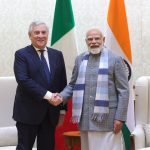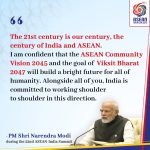
In diplomacy, the optics matters as much as substance. There were smiles all around as Chinese Premier Li Keqiang touched down in the Indian capital (May 19) on a headline-stealing visit to inject “a new vigour” in the relationship between India and China, that was challenged by a tense stand-off between their border troops on the icy slopes of Ladakh only weeks ago.
The ice appears to have melted slightly since then; and it’s clearly not the soaring mercury in New Delhi. Instead of a summer of discontent, predicted by hawks on both sides, the powers-that-be in the two countries are heading for some serious focused diplomacy to address prickly issues upfront and to map the way ahead for this critical relationship that is often portrayed as adversarial and sadly remains embroiled in strategic mistrust. That’s why the symbolism and gestures will be as important as substantive outcomes and pacts during the Chinese premier’s May 19-22 visit to India.
Symbolism and Vision
Talking of symbolism, the Chinese premier’s itinerary has been carefully crafted to provide some windows of opportunity for the Chinese premier to interact with civil society and businessmen. In a first of sorts for a Chinese leader, Li Keqiang will be addressing university students in New Delhi, a day after his talks with Indian counterpart Manmohan Singh. The premier’s speech should be scrutinised carefully as it should provide a deeper insight into China’s long-term vision of its relations with India, the world’s most populous democracy and an emerging economy Beijing sees as an opportunity as well as a competition to its not-so-hidden ambition for pre-eminence in a new world order. The speech will be important not only for what it says, but what it does not. His visit to Dr Kotnis’ family in Mumbai and his interaction with India Inc. in Mumbai also seeks to push China’s soft power drive in a country where the media and commentariat are gorged with gloomy prognostications of rivalry between the two restless Asian giants.
‘A Blessing for Asia’
Against this backdrop, Li chose his words carefully after touching down in the Indian capital May 19. In a written statement, Li underlined the imperative of harmonious co-existence between India and China and spoke about how it serves the fundamental interests of the two countries and their people. It is a blessing to Asia and the world at large that China and India coexist peacefully, maintain friendly relations and work together to realise national rejuvenation, he said.
Clearly, Premier Li has not come to India on his first overseas visit to simply spout rhetoric of peace and harmonious co-existence; India and China are expected to sign a clutch of pacts and firm up some in-principle understandings to resolve more complex and contentious issues like the boundary dispute, the ballooning trade deficit and the proposed Chinese dams on the Brahmaputra river which has triggered anxiety in India about Beijing’s intentions. With the Ladhak incursion highlighting the damage potential of such incidents in the future, the two leaders are expected to focus on bolstering mechanisms for maintaining peace and tranquillity in border areas. They are also expected to instruct their special representatives to fast-track the process of firming up a framework for resolving the boundary question from the long-range strategic perspective of building stronger India-China relations over the next few decades.
On the economic side, one can expect the Chinese premier to assure India about enabling the entry of Indian IT and pharmaceutical companies into the competitive Chinese market. In this context, the premier’s visit to the facilities of Tata Consultancy Services (TCS) in Mumbai is significant as it has become a symbol of potential Indian IT success story in China. The strategy of bridging trade imbalance, which is heavily skewed in favour of China, with Chinese investment in manufacturing facilities in India is expected to get a boost.
Medium is Message
While all these so-called deliverables and outcomes will be important and have positive spill-over effects on bilateral ties, the heart of the Chinese premier’s visit is the broader message and formulation about the future of India-China relations and a deliberate and incremental strategy to dispel the notions of rivalry and confrontation that have framed so much of discourse and media commentary on the India-China relations. The Chinese official media is assiduously at work, disseminating this message of India and China as partners, not rivals. The state-owned Xinhua news agency says the “choice of India as the first leg” of Li’s maiden overseas trip “sent out a clear signal that Beijing’s new leadership prioritizes enhancing ties with New Delhi despite border spats and other disputes. “The China-India relationship is more about the future than about the past. It is with such a forward-looking mind that China’s new leadership has decided to take new initiatives to further deepen bilateral ties and mutual trust. Li’s upcoming trip will be a crucial step in that direction.” In an article in People’s Daily, China’s ambassador to India Wei Wei says that Li’s visit “will open a new chapter in Sino-Indian relations”.
Beyond Optics
Ahead of his visit, Premier Li told a visiting India youth delegation in Beijing that “China and India are important neighbors and partners by nature.” The China-India relationship is not only of great strategic significance to Asia and the world, but also concerns the destiny and interests of the two countries’ combined population of 2.5 billion, said Li. By 2020, the population of the two countries will outstrip 3 billion people. Can the leaders of the two Asian counties afford to trifle with the lives and fortunes of three billion people? It’s time for India and China to seize the moment and back up the florid rhetoric of harmonious coexistence with more pragmatic cooperation and opening new win-win opportunities for two-fourth of the world’s humanity. There is really no other way out, but to co-exist harmoniously and prosper.
Author Profile

- Manish Chand is Founder and Editor-in-Chief of India Writes Network (www.indiawrites.org) and India and World, a pioneering magazine focused on international affairs. He is CEO, Centre for Global India Insights, an India-based think tank focused on global affairs.
Latest entries
 India and the WorldDecember 12, 2025India-Italy bonding: Tajani’s visit raises the bar for business, maritime ties
India and the WorldDecember 12, 2025India-Italy bonding: Tajani’s visit raises the bar for business, maritime ties In ConversationNovember 26, 2025G20 is a Force for global Good
In ConversationNovember 26, 2025G20 is a Force for global Good articlesNovember 26, 2025Rescuing G20 from North-South divide: Ubuntu Moment
articlesNovember 26, 2025Rescuing G20 from North-South divide: Ubuntu Moment India and the WorldOctober 27, 2025Modi hails the century of India and ASEAN, backs ASEAN centrality
India and the WorldOctober 27, 2025Modi hails the century of India and ASEAN, backs ASEAN centrality







